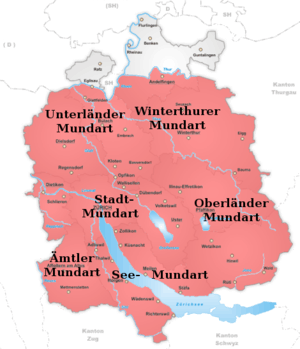Zurich German


Zurich German (German: Zürichdeutsch, Zurich German: Züritüütsch) is the High Alemannic dialect spoken in the Canton of Zurich, Switzerland.
It is divided in six sub-dialects, covering the entire Canton with the exception of the parts north of the Thur and the Rhine.
- The dialect of the town of Zürich (Stadt-Mundart)
- The dialect spoken around Lake Zurich (See-Mundart)
- The dialect of the Knonauer Amt west of the Albis (Ämtler Mundart)
- The dialect of the area of Winterthur
- The dialect of the Zürcher Oberland around Lake Pfäffikon and the upper Tösstal valley
- The dialect of the Zürcher Unterland around Bülach and Dielsdorf
Like all Swiss German dialects, it is essentially a spoken language, whereas the written language is standard German. Likewise, there is no official orthography of the Zurich dialect. When it is written, it rarely follows the guidelines published by Eugen Dieth in his book Schwyzertütschi Dialäktschrift; in fact, only language experts know about these guidelines. Furthermore, Dieth's spelling uses a lot of diacritical marks not found on a normal keyboard. Young people often use dialect for personal messages, such as when texting with their mobile phones. As they do not have a standard way of writing they tend to blend Standard German spelling with Swiss German phrasing.
The Zurich dialect is generally perceived as fast spoken, less melodic than, for example, the Bernese. In the northern parts of the canton, the "r" is pronounced as a uvular trill, whereas in the city around the lake and in the southern parts, it is pronounced as an alveolar trill.
Characteristic of the city dialect is that it most easily adopts external influences; in particular, the second generation Italians (secondi) have had a crucial influence, as has the English language through the media. The wave of Turkish and ex-Yugoslavian immigration of the 1990s is leaving its imprint on the dialect of the city in particular.
Example
The following text is an example of Zürichdeutsch taken from a news article:
- "Wiä's Bieler Tagblatt uf sinerä Online-Plattform am Nammitag brichtet hät, sind d'Strassesperrigä i Biel wiedr ufghobe wördä. D'Strassä seget wiedr befahrbar und d'Polizeiaktion isch beendet wördä. D'Polizei hät am Mittwuch Morgä ufnerä Boustell äs vrdächtigs Paket gfundä chaa und churz druf s'Gbiet um d'Bieler Spitalstrass abgsperrt. D'Öffentlichkeit sött i de nächschtä paar Stundä über d'gnoieri Umständ informiärt werdä."
Here is the following text translated into standard German, or Hochdeutsch:
- "Wie das Bieler Tagblatt auf seiner Online-Plattform am Nachmittag berichtet hat wurden die Strassensperren in Biel wieder aufgehoben. Die Strassen seien wieder befahrbar und die Polizeiaktion wurde beendet. Die Polizei hatte am Mittwochmorgen auf einer Baustelle ein verdächtiges Paket gefunden und kurz darauf das Gebiet um die Bieler Spitalstrasse abgesperrt. Die Öffentlichkeit soll in den nächsten Stunden über die genaueren Umstände informiert werden."
And finally, the text translated into English:
- "As Biel's daily paper stated on its online platform in the afternoon, the roadblocks in Biel had been lifted. It stated the streets were driveable again and the police operation had finished. On Wednesday morning, the police found a suspicious package at a construction site and shortly after, they closed off the area around the 'Bieler Spitalstrasse.' The public will be informed about the situation with more detail in the next few hours."
Further reading
- Dieth, Eugen (1986). Schwyzertütschi Dialäktschrift (in German). Aarau: Sauerländer. ISBN 978-3-7941-2832-7. (proposed orthography)
- Salzmann, Martin: Resumptive Prolepsis: A study in indirect A'-dependencies. Utrecht: LOT, 2006 (=LOT Dissertation Series 136). Chapter 4: Resumptives in Zurich German relative clauses, online .
- Weber, Albert: Zürichdeutsche Grammatik. Ein Wegweiser zur guten Mundart. With the participation of Eugen Dieth. Zürich (=und Wörterbücher des Schweizerdeutschen in allgemeinverständlicher Darstellung. Bd. I). (prescriptive grammar book) (German)
- Weber, Albert and Bächtold, Jacques M.. Zürichdeutsches Wörterbuch. Zürich (=Grammatiken und Wörterbücher des Schweizerdeutschen in allgemeinverständlicher Darstellung. Bd. III). (Zurich German—Standard German dictionary)
- Egli-Wildi, Renate (2007). Züritüütsch verstaa, Züritüütsch rede (108 pages + 2 CDs) (in German). Küsnacht: Society for Swiss German, Zürich Section. ISBN 978-3-033-01382-7. (a study book for Zürich German, intended for fluent German speakers)
- Fleischer, Jürg; Schmid, Stephan (2006). "Zurich German" (PDF). Journal of the International Phonetic Association 36 (2): 243–25. doi:10.1017/S0025100306002441.
- Gallmann, Heinz (2009). Zürichdeutsches Wörterbuch [Zurich German Dictionary] (in German). Zürich: . ISBN 978-3-03823-555-2.
